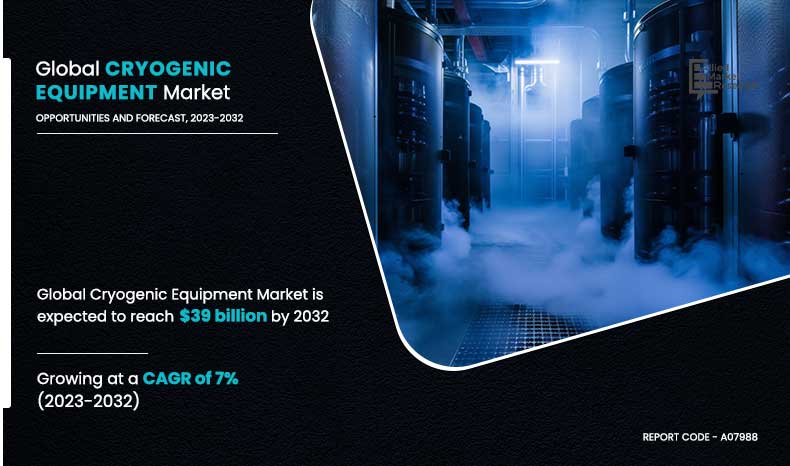Cryogenic Equipment Market Ovrview
The Global Cryogenic Equipment Market size was valued at $19.9 billion in 2022, and is projected to reach $39 billion by 2032, growing at a CAGR of 7% from 2023 to 2032.
Cryogenic tanks are opted for storage and transportation of liquefied industrial gases such as hydrogen, oxygen, helium, nitrogen, and argon.
Market Introduction and Definition
They are primarily designed to store liquefied gases below temperature of -150°C. They are available in various configurations such as vertical, horizontal, double-walled, and insulated. They can be static or fixed and mobile or transportable. They have wide applications in multiple industries such as medical technology, food, electronics, and metal processing.
Cryogenic gear encompasses various types of plant and machinery used in processing and handling substances at extremely low temperatures, typically below -150 degrees Celsius (-238 degrees Fahrenheit). These are vital for numerous industrial, scientific and medical procedures that require gases or materials to be stored, transported or manipulated in their cryogenic state. Broadly speaking, popular examples include storage tanks for cryogenic fluids, liquefiers, refrigerators and transfer lines. Such systems use advanced insulation methods as well as the refrigeration process to adequately maintain extreme low temperatures while also stopping heat from being transferred to the surrounding area.
Cryogenic equipment has many uses such as healthcare industry (for preserving biological samples), energy sector (for storing and transporting Liquefied Natural Gas), aerospace (for storing rocket fuels) among others. Also it is used in research work such as superconductivity experiments and particle physics experiments..
The cryogenic equipment market is driven by increasing LNG demand in energy, healthcare, and electronics sectors. Healthcare's adoption for medical imaging and sample storage also boosts growth. Technological advancements, like more efficient systems, propel expansion. However, high initial costs, safety concerns, and regulatory hurdles restrain the market. Opportunities arise from aerospace and automotive industries' cryogenic applications and the focus on sustainable energy like hydrogen storage. Advancements in materials science promise more durable and efficient equipment, fostering market growth.
For instance, in March 2024, Chart Industries announced its business expansion of Teddy 2 facility in Theodore, Alabama, capable of manufacturing what is believed to be the world’s largest shop-built cryogenic tanks. In addition, the US cryogenic equipment specialist said that tanks manufactured at the site will be used for propellant storage for the aerospace industry, hydrogen, and LNG storage for marine and power, and gas by rail, among other.
There is an increase in natural gas consumption, a rise in need for clean energy production technologies such as LNG, and an increase in demand for metallurgical processes. These factors are anticipated to boost the market for cryogenic equipment, such as tanks, vaporizers, and other equipment. Liquefied natural gas (LNG) is expected to experience a rise in demand owing to its optimistic environmental adaptability and its advantages as a cleaner alternative to conservative fossil fuels during the forecast period.
As LNG requires specialist equipment for storage, transport, and regasification, there is an increase in the sales of cryogenic equipment. Cryogenic equipment is an essential component in the setup of LNG supply chain, such as liquefaction plants, LNG storage tanks, and shipping vessels. These equipment components must be made to withstand extremely low temperatures since natural gas is preserved in its liquefied state via cryogenic operations. As the demand for LNG rises, more investments are expected in the LNG infrastructure and cryogenic equipment market growth.
Maintaining cryogenic temperatures requires a substantial amount of energy. The operational costs for cooling and insulation are anticipated to rise as a result, which may have an effect on the equipment's overall cost. For cryogenic applications to operate safely and effectively in low-temperature conditions, specialized infrastructure is often needed. This calls for the use of properly insulated containers, unique storage facilities, and security measures to guard against mishaps or gas leaks. It can be expensive and complicated to meet these infrastructure needs, which makes it challenging for many businesses to adopt cryogenic technologies. In addition, due to their capacity to replace oxygen and their low temperatures, cryogenic materials like liquid helium and liquid nitrogen may be detrimental to human health. It takes specialized safety procedures, tools, and facilities to handle and store cryogenic materials securely. A group of qualified professionals is therefore required for the operation of this equipment. As the cryogenic equipment market forecast may be impacted by such factors.
The storage and delivery of materials and propellants at extremely low temperatures are made possible by cryogenic equipment, which is essential to space travel. Several space missions need the use of these cryogenic technologies, which also present several prospects for advances and scientific discoveries in space exploration. In contemporary rocket engines, cryogenic fuels such as liquid oxygen (LOX) and liquid hydrogen (LH2) are used. Propulsion systems are effective because of the high specific impulse that these fuels offer. Cryogenic equipment can be used to liquefy gases found on the Moon or Mars, such as water ice, to make propellants locally. It is utilized to store, handle, and distribute these propellants to the rocket engines. This would make colonization and a sustained human presence on these asteroids more possible by greatly reducing the expense and logistical difficulties associated with transporting propellants from Earth.
Major Key Players
LAPESA GRUPO EMPRESARIAL, Linde plc, Cryolor, Auguste Cryogenics, Cryofab, Inc., Emerson Electric Co., Chart Industries, Nikkiso Co., Ltd., INOX India Limited, and MAN Energy Solutions. Acquisition and strategic partnership are common strategies followed by major market players.
For instance, in May 2022, Chart Industries, Inc. acquired CSC Cryogenic Service Center AB, a Swedish company. The acquisition is expected to expand the geographic presence, coupled with the expansion of company’s repair and service capabilities for mobile equipment, in particular trailers, as well as stationary and transportable tanks, ISO containers, flowmeters, pumps, and LNG fueling stations. Chart Industries has a huge customer base looking for exclusive full care maintenance and service agreements in the Nordic region as well as commissioning and installation capabilities for LNG stations. The acquisition of CSC would also bring firm relationships with major customers in the marine industry and utilizing the company’s global commercial team.
The cryogenic equipment market is segmented on the basis of product, gas type, application, and region. By product, the market is divided into tanks, valves, vaporizers, pumps, vacuum jacketed piping, and others. By gas type, the market is bifurcated into nitrogen, oxygen, argon, LNG, and others. By application, the market is classified into storage and distribution. By region, the market is analyzed across North America, Europe, Asia-Pacific, and LAMEA.
Market Segmentation
The Cryogenic Equipment Market is Segmented into Product, Gas Type and Application.
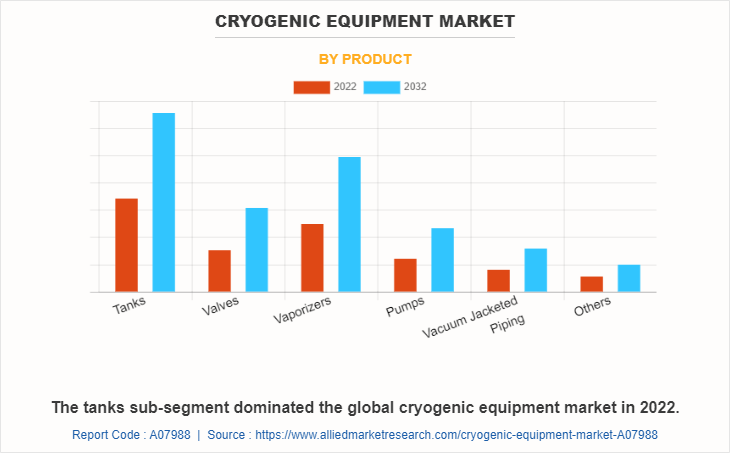
By Product,
the tanks sub-segment dominated the global cryogenic equipment market in 2022. Cryogenic tanks are majorly used for the transportation and storing of cryogenic gases like liquid oxygen, liquid nitrogen, liquefied natural gas (LNG), and other gases used in industrial applications. The demand for cryogenic tanks in various industries is expected to increase including energy, healthcare, and aerospace. As a result of the requirement for natural gas and its quality to burn cleanly, the demand for liquefied natural gas (LNG) has been considerably increased. Since cryogenic tanks play an essential role in the transportation and storage of LNG, the demand for cryogenic equipment is expected to increase as more LNG facilities and terminals are built. In the industrial and healthcare sectors, cryogenic tanks are opted for the storage and transportation of cryogenic materials such as nitrogen and liquid oxygen. Due to their significance in operations like cryopreservation, cryosurgery, and numerous medical procedures, there is a chance of an increase in demand for these gases. Cryogenic tanks are also necessary for numerous other scientific and research sectors, including superconductivity, low-temperature physics, and material science. As R&D projects advance, there might be a greater requirement for cryogenic tanks to support such studies.
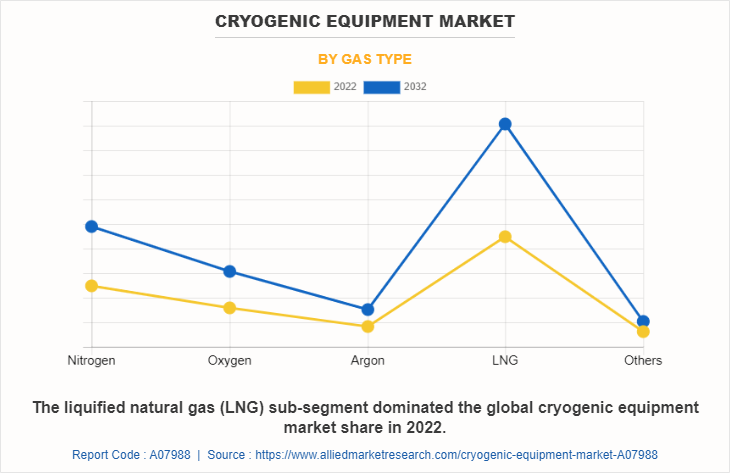
By Gas Type,
The liquified natural gas (LNG) sub-segment dominated the global cryogenic equipment market share in 2022. LNG has been progressively accepted as an alternative to conventional energy sources, particularly in regions without access to natural gas pipelines. Countries majorly in Asia-Pacific such as China, Japan, South Korea, and India are some of the foremost importers of LNG, however Europe also observed a growing demand for LNG to expand its energy mix. In addition, numerous industrialized and developing nations are advancing towards cleaner energy sources owing to the rising awareness related to battling climate change and lowering carbon emissions. LNG is deemed as a substantially cleaner fossil fuel in comparison to oil and coal as it emits fewer greenhouse gas emissions when exhausted for electricity production and other industrial purposes. The development of petrochemicals, steel, and equipment manufacturing are among a few of the industrial processes where LNG is frequently utilized. It is expected that as industries expand, correspondingly the demand for LNG as a fuel source else feedstock will rise.
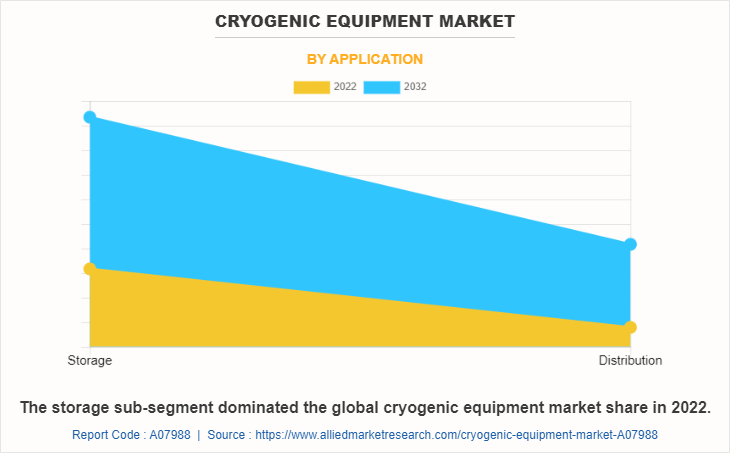
By Application,
The storage sub-segment dominated the global cryogenic equipment market share in 2022. Cryogenic storage is crucial for LNG production and transportation. Natural gas is cooled to cryogenic temperatures to convert it into a liquid state, reducing its volume for easier and more efficient transport. In addition, cryogenic gas storage is commonly used for storing industrial gases such as nitrogen, oxygen, argon, and helium. These gases are used in various applications, including welding, metal fabrication, and medical purposes. Furthermore, cryogenic storage is widely used in storing biological samples, such as stem cells, tissues, blood components, vaccines, and other biomaterials. The low temperatures help slow down biological activity and chemical reactions, preserving the samples for future use in research, medical treatment, and diagnostics. Some medications, especially certain vaccines and biological drugs require cryogenic storage to maintain their stability and potency for an extended period. Certain materials used in superconducting applications require cryogenic temperatures to maintain their superconducting properties, enabling highly efficient electrical transmission and other technological advancements.
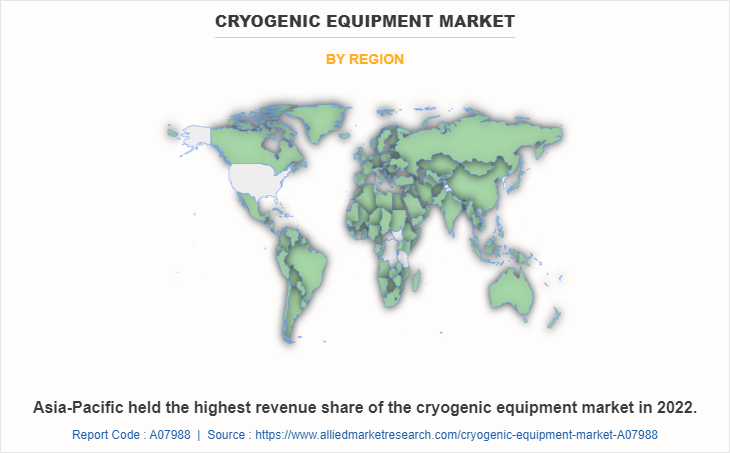
By Region,
Asia-Pacific dominated the global cryogenic equipment market in 2022. The cryogenic equipment market in Asia-Pacific is growing owing to prompt industrialization and technological advancements. Cryogenic equipment finds application in industries such as pharmaceuticals, chemicals, and LNG that require low-temperature processes, storage, and transportation. As these industries expand, the demand for cryogenic equipment is likely to grow. Asia-Pacific is a major consumer of LNG due to its increasing energy demands and cryogenic equipment is essential for the liquefaction, transportation, and regasification of LNG. As the demand for cleaner energy sources rises, the LNG market is projected to grow, driving the demand for cryogenic equipment. In addition, space agencies and private space exploration companies in Asia-Pacific are actively involved in space research and satellite launches. The equipment is used in rocket propulsion systems, such as liquid hydrogen and oxygen storage and delivery systems. The growing space industry in the region is anticipated to contribute to the demand for cryogenic equipment.
Impact of COVID-19 on the Global Cryogenic Equipment Industry
- The COVID-19 pandemic has had a significant impact on various industries, including the manufacturing industry. The pandemic led to disruptions in global supply chains, affecting the availability and delivery of cryogenic equipment, machinery, and raw materials. This disrupted the operations of cryogenic equipment companies, causing delays in project timelines and production.
- For cryogenic equipment, industries like healthcare and pharmaceuticals witnessed an increase in need for cryogenic freezers and storage tanks for vaccine distribution and other medical purposes. On the contrary, industries like aerospace and certain research sectors witnessed a decrease in demand, which influenced production patterns.
- The economic uncertainty caused by COVID-19 made it difficult for certain cryogenic equipment manufacturers to secure financing. Investors became more cautious, leading to a decrease in funding for new projects or expansion of existing ones. This uncertainty affected the long-term planning and investment decisions of cryogenic equipment companies.
- During the pandemic, the need for cryogenic equipment became apparent as countries around the world began mass vaccination campaigns to curb the spread of COVID-19. Vaccination centers, hospitals, and research facilities required specialized freezers and containers to store and distribute vaccines safely.
Key Benefits For Stakeholders
- This report provides a quantitative analysis of the market segments, current trends, estimations, and dynamics of the cryogenic equipment market analysis from 2022 to 2032 to identify the prevailing cryogenic equipment market opportunities.
- The market research is offered along with information related to key drivers, restraints, and opportunities.
- Porter's five forces analysis highlights the potency of buyers and suppliers to enable stakeholders make profit-oriented business decisions and strengthen their supplier-buyer network.
- In-depth analysis of the cryogenic equipment market segmentation assists to determine the prevailing market opportunities.
- Major countries in each region are mapped according to their revenue contribution to the global market.
- Market player positioning facilitates benchmarking and provides a clear understanding of the present position of the market players.
- The report includes the analysis of the regional as well as global cryogenic equipment market trends, key players, market segments, application areas, and market growth strategies.
Cryogenic Equipment Market Report Highlights
| Aspects | Details |
| Market Size By 2032 | USD 39 billion |
| Growth Rate | CAGR of 7% |
| Forecast period | 2022 - 2032 |
| Report Pages | 320 |
| By Product |
|
| By Gas Type |
|
| By Application |
|
| By Region |
|
| Key Market Players | Linde plc, NIKKISO, MAN Energy Solutions, Cryolor, INOX India Limited, Emerson Electric Co., Chart Industries, LAPESA GRUPO EMPRESARIAL, Cryofab, Inc., Auguste Cryogenics |
The increasing natural gas consumption, rising need for clean energy production technologies, such as LNG and increasing demand for metallurgical processes are factors anticipated to boost the market for cryogenic equipment. In the upcoming years, liquefied natural gas (LNG) is expected to experience a rise in demand owing to its optimistic environmental adaptability and its advantages as a cleaner alternative to conservative fossil fuels.
The major growth strategies adopted by the cryogenic equipment market players are acquisition and partnership agreements.
Asia-Pacific will provide more business opportunities for the global cryogenic equipment market in the future.
LAPESA GRUPO EMPRESARIAL, Linde plc, Cryolor, Auguste Cryogenics, Cryofab, Inc., Emerson Electric Co., Chart Industries, NIKKISO, INOX India Limited, and MAN Energy Solutions, are the major players in the cryogenic equipment market.
The tanks sub-segment of the product segment acquired the maximum share of the global cryogenic equipment market in 2022.
Oil & gas and healthcare companies are the major customers in the global cryogenic equipment market.
The report provides an extensive qualitative and quantitative analysis of the current trends and future estimations of the global cryogenic equipment market from 2022 to 2032 to determine the prevailing opportunities.
Cryogenic storage is crucial for LNG production and transportation. Natural gas is cooled to cryogenic temperatures to convert it into a liquid state, reducing its volume for easier and more efficient transport. These applications are projected to drive the adoption of cryogenic equipment.
Cryogenic equipment plays a crucial role in space exploration, enabling the storage and transportation of materials and propellants at extremely low temperatures. These cryogenic systems are essential for various space missions and offer several prospects for advancements and breakthroughs in space exploration.
Loading Table Of Content...
Loading Research Methodology...

